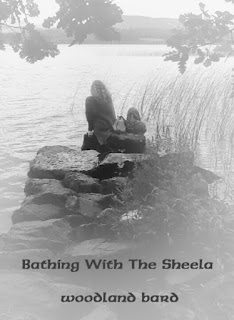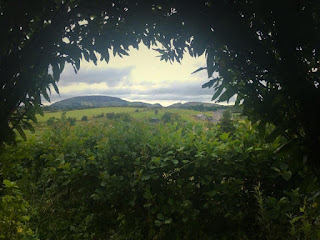Daghda And The Coire Cíuín part two
Please support Bathing With The Sheela, and our Labyrinth Gardens work, as a Patron, from a dollar, a euro, a pound, a month ...
Become a Patron!
To recap, for this third part of a five part series ...
This is a legend of the deeds of Daghda, often pronounced like Doyda, that is a lovely ancient story example of passage through three stages of what is called a Hero’s Journey.
Departure - the call for adventure. breaking from the mundane
Initiation - the meeting with the Goddess, Fae, Sidhe, your spirit mentor
Return - the courage and freedom to journal and live from your inspiration
Daghda had approached the well of the Cailleach to drink and bathe and return his stamina, so he could return as the god of harvest and abundance each autumn harvest time
At the well he met the three hags, the Morrigna, and actually not bad looking.
Their names are Badb (Medb, Maeve), Macha and Nemain, (Fea, Fae).
They had invited Daghda back to stay with them, lay with them, love them, etc., within the hill.
As a ‘Hero’s Journey’ a departure from his routine, ‘mundane’.
So where is this place of sleeping, dreaming,
embracing and loving that Daghda
is about to adventure into?
For anyone who entered through the caves into the Hill of Keash, if you go in deep enough there is a large lough. It is the receiver of the ‘fallen’. Many of us would just say dying. The bodies of life where the life is flowing away, such as the autumn leaves falling.
This lough’s depths is where at midwinter the water becomes hot. It is the Coire Cíuín where the departed life of the year before comes to rest, and is transformed and woven into the new life to be born the following spring.
So how am I here to tell you this? Well that is another story I will tell in a future feature.
Does anyone know about the Yule Log tradition before Christmas Day?
Various stories have been passed down about this tradition, that seems to be a combo of Norse and Germanic tradition.
I relate to the one of the oak log being of Odin,
resting in the fire hearth of Freya’s womb.
Sadly, there are not enough Oaks to supply everyone any more. to go around any more.
As soul singer Millie Jackson once said, in the middle of her cover of ‘Keep The Home Fire Burning’, “I have a hearth in me. The ashes are cold, the fire has gone out. What I need is a log on my hearth that ignites and fires. A good hard log, a long log, one that burns for hours, and hours”.
Hmm, I think I will continue the story of Daghda.
So there was poor Good Good Daghda, waning in stamina, but following the three hags, from the well, into the caves. He was still holding onto his cauldron pot of plenty, and dragging his club of protection, but he did NOT bring in his cruitre, his harp of inspiration.
That was left outside as a sign, for those who may pass, that he was there inside the hill.
Daghda was guided through the caves, getting narrower, into the womb of the Cailleach. The caves paths are quite a labyrinth to the lough pool within the Cailleach womb, the Mor na Coire Ciuin. as he entered deeper the three hags seem to fade i to his shadow, until he could see them no more.
Let me tell you more about that lough pool.
When the Cailleach’s womb first rose from the earth the water of the womb, the Mor na Coire Ciuin Lough, pushed and burst through her vulva, the caves.
And four serpents, some say dragons as they were born from fire in the water, wriggled and formed gullies for the womb water to flow away across the land. The four serpents formed four gullies, that were filled with four rivers over what is now Ireland.
Inshin to the North, Grainne to the East, Sianann to the South, and Brideog to the West.
Those four rivers drained the sea of Spring’s water formed around the hill above Keash, flooded from the Mor na Coire Cíuín Womb lough, every Spring. This at the time of Imbolc, the middle of the time of Aquarius, the water bearer.
The rivers flowed, plus rain trickled from the clouds formed from evaporation from the rivers, fertilised this island, now Erin, now Ireland, so that the seeds of Spring can awaken and flourish.
Now here is the heat of this Daghda story.
Daghda was silently invited, by an invisible voice, to enter into the Mor Na Coire Ciuin pool, and drop his cauldron of plenty into it.
It’s infinite harvested content dissolved within the water of the pool. He stirred all of this with his club and remember, he left his cruitre harp outside.
The water became milky and caressing. Each day from Samhain towards Midwinter, Daghda was urged to continue to bathe daily and never leave the hill. He would still never become hungry.
Each day the lough pool became thicker and warmer. He still entered every day until Midwinter. Each day he would bathe longer than the day before. Eventually he just did not want to climb out. He was totally comforted within this pool womb.
When Midwinter arrived, the pool was like porridge, the bubbling heat was at it’s hottest. At that moment, Daghda’s whole being, body, senses and spirit became at one with the Mor na Coire Ciuin, a tantric, timeless, spaceless, oneness, embraced him wholey, and transformed him into a new man.
At that following Spring a son and daughter were born.
Since then, stories have been told, and are still being told, about The Daghda and the Morrigan Hag laying together and consummating .
Their daughter of that Spring, became Bridgeod as she dedicated her life to the passions of the spirit that created the seeding Brideog river to the west. She was the fire keeper, especially arranging for the fuel, and harvests, for the midwinter heating of the Mor na Coire Cuin.
And thinking of ancient fires have you heard of the Fulachtaí Fladh? The remains of these ancient sites are told by many as the cooking area of the ancients. A place where stones are heated and thrown into a huge man made pool of water to make it boil and cook meat, fish, and maybe root vegetables and herbs.
Maybe this was so, but I think early people found it was quicker and easier to just roast foods over a fire. So what were these Fulachtai Fladh places for?
Inside the Cailleach womb, the Mor na Coire Ciuin, the heating at mid winter, and bubbling ... is also known as the Fulachta.
Daghda’s pot of cereals fermented in the Fulachta that also created fermented ale in the womb of the Cailleach.
Is this why Brighid is also the goddess of ale?
Fire and water becomes a sacred space
... that’s in this realm between the dark of earth and light of air.
When the steam of this sacred hot pool dripped from cold stones, for those who can taste this, ‘fire water’ Uisce Beatha was born.
Discoveries by early 20th century archaeologists did not find burials and bones inside these Caves of Céis, of the hill above Keash. However, within each cave they did find traces of fires.
Were these fires created and lit by local people to honour the need of heat within the Mor na Coire Ciuin? Were these lit to aid her pool heating each mid winter to complete her weaving, so that we could have a blessed spring? Or were these fire hearths places of creating the Uisce Beatha?
Today, there is still mid-winter ale brewing in Eastern Europe using natural yeast in the air at this time. It was some of this ale, or cider, that was used to bless the apple and other fruit trees around what we call Epiphany now. Parts of England and SE Ireland still engage in this tradition, Wassailing.
Mid winter, the fires
to warm the goddesses womb
A tradition of the norse, the germanic and the ghaels
The sea people,
the forest people
and eventually the farming people
So, were these Fulachtaí fiadh ancient places for people to fire up, make the ale, make the cider, to warm them mid winter. Made to fire up each other at mid winter.
As I mentioned, some of this brew seems to have been poured onto the roots of fruit trees, the apple trees, and the people who join in for this known as ‘the wassailers’.
But the rage, oh the rage, of those who drank these potions of midwinter. The rage, the fighting, and the blame on the Mor na Coire Ciuin who became their image of their demon.
Morrigan the demon,
The fighting warrior
The consumer of flesh,
And spirit of those who had
Fallen in battle from this rage.
But those who knew of this burden of rage, burned sticks of a tree, that I will include some tales of through the next third part of Daghda And The Coire Cíuín part three.
Burning the sticks to call upon the triple hag Morrigna to return them to peace.
Again to recap ...
Their daughter of each Spring, became Bridgeod, Brid, Brighid, as she dedicated her life to the passions of the spirit of the new birth of Spring. She is the fire keeper, especially arranging for the fuel, and harvests, for the midwinter heating within the Mor na Coire Cuin.
Tune is to complete this story cycle with part three tomorrow.












Comments
Post a Comment